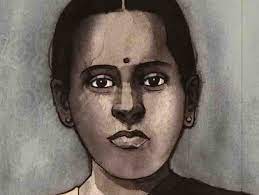Mahakavi Subabaramanya Bharatiyar, (1914) praised “Anjalai Ammal has come into public life at a time when women are afraid to step out of the house.”
This same lady was later hailed as ‘Queen Jhansi of South India’ by Mahatma Gandhi.
Thus, respected by leaders like Rajaji, Kamaraj, shall we spend some time to know more about Anjalai Ammal?
Born in a weavers family in Cuddalore district on June 1, 1890, Anjalai studied in Ammal village school till class 5. In 1908, she got married to Murugappa from the same district. Both the couple had a passion to join the independence movement. They were also attracted by the leadership of Gandhiji.
They participated in the Non-Cooperation Movement in 1921, and later in 1927 played an important role in the history of liberation. From 1857, patriots who took an active part in the First War of Independence were brutally killed and hanged from trees by Colonel Neil, who thereby claimed to have sent a clear warning if anybody harbours an idea to raise against foreign rulers. Col. Neil was killed in the siege of Lakshmanapuri Palace within months, and in 1860 his statue was erected in Spencer Complex in the present day Anna Salai in Chennai. In 1927, the Chennai Mahajana Sabha and the Indian National Congress jointly organized a great struggle for the removal of the . Not only Anjalai Ammal and her husband but also their 9-year-old daughter Ammakannu participated in it. The parents were sentenced for one year imprisonment for vandalizing the statue. (Daughter confined to reform school for 4 1/2 years). Anjalai Ammal was one of the two (Madurai Padmasini Ammal being the other) women freedom fighters who were imprisoned by British Raj.
Gandhiji heard about Murugappa-Anjalai Ammal during his tour of Tamil Nadu and visited them in jail in Cuddalore. praised their daughter Ammakannayam, and after her release named her Lilavati, took her to Wardha Ashram and brought her up.
In Cuddalore, Anjalai Ammal was sentenced to 6 months imprisonment on January 10, 1931 for participating in salt satyagraha and was imprisoned in the Vellore Women’s Jail. She was 6 months pregnant at that time.
A month later, she was on parole and gave birth to a baby boy. After that, she went to jail with the infant of 15 days and served the remaining two months of her sentence. The child was born on parole from prison and was named ‘Jail Veeran’. Later he was called ‘Jayaveeran’.
Anjali presided over the All India Women’s Congress meeting in Chennai in 1931.
In 1932, she organized a Liqour shop picket to rally the public in support of Gandhi’s Prohibition policy and was sentenced to nine months’ rigorous imprisonment in the Bellary Jail.
In 1933, she participated in the boycott foreign goods stir and was sentenced to three months in prison.
In 1940, she participated in the individual satyagraha struggle and was sentenced to 6 months of rigorous imprisonment in Kannur Jail.
Anjalai Ammal participated in the Quit India Movement (1941-42) and traveled to many cities including Chennai and went to jail for giving speeches. Thus, she spent a total of 4 years and 5 months in prison. Each time her fighting spirit only went up and never wavered.
Following example will confirm the above statement. When Gandhi came to Cuddalore in 1934, he tried to meet Anjalai Ammal but the government did not permit the meeting. However, Anjali Ammal came in a horse-drawn carriage wearing burqa and met Gandhi. It was then that Gandhiji called her the “Jansi Rani of South India” pointing to Anjali’s bravery.
After India’s independence in 1947, she refused to receive the government’s pension announced for the freedom fighters who spent jail terms.
She was elected from Cuddalore constituency as a member of Chennai Provincial Legislative Assembly three times in 1937, 1946 and 1952.
Simple, blemishless and self-sacrificing Anjalai Ammal’s life ended on 20th February 1961, and on this auspicious day let us honor her memory and pledge to rededicate ourselves for the national cause.
M.R.Jambunaathan

